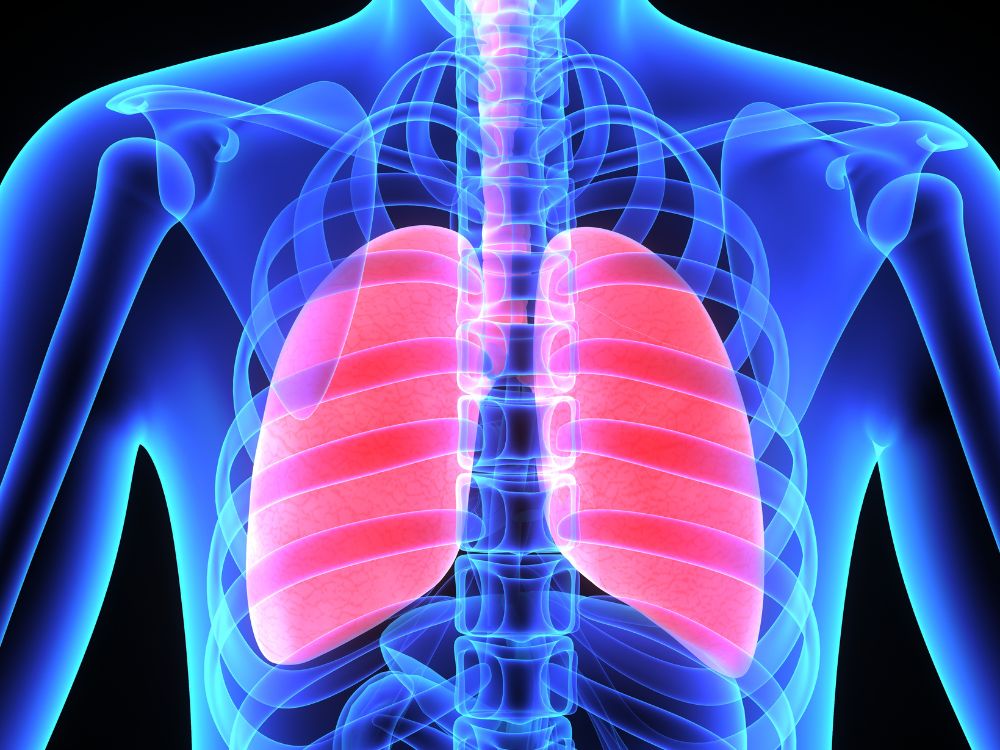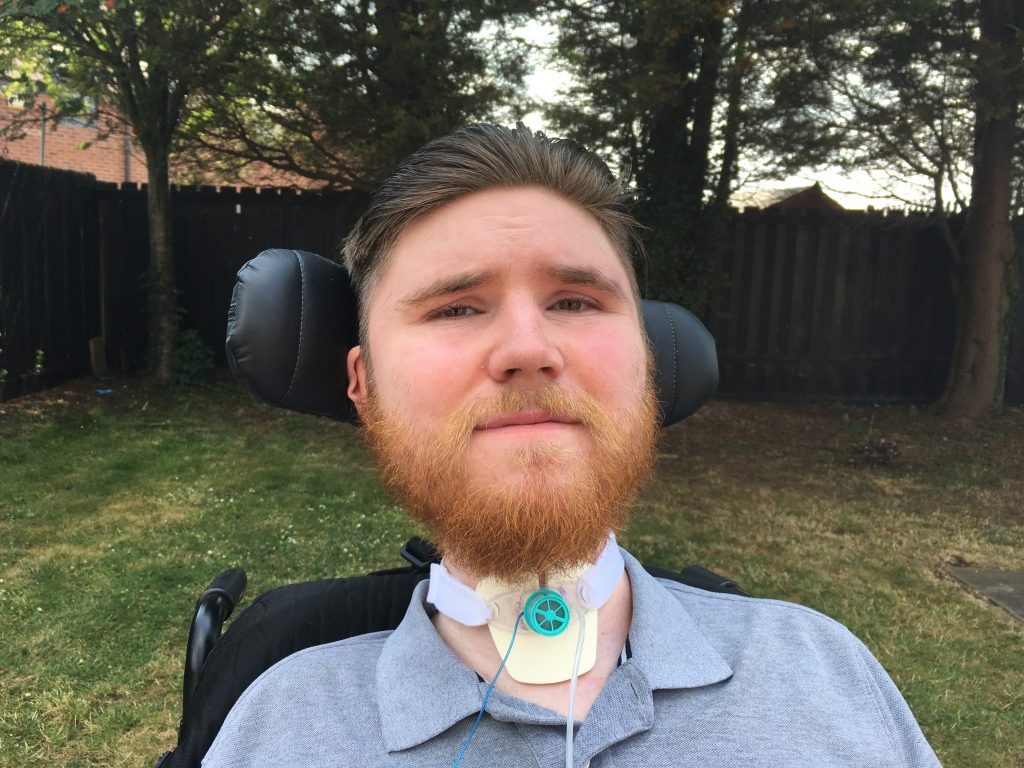
Living With Progression: Breathing, Food, and More

This article carries on from the article that I wrote for Pathfinders last summer, where I talked about living with a tracheostomy. That only tells part of my story, this article is going to delve deeper. At the same time I had the trache fitted, I had a feeding tube put in and I moved onto overnight ventilation. I also went from a few hours of care a week, to a 24 hour care package, with 2 to 1 care. I’ve had to get used to all of these other things, so I thought I should talk about my experiences.
As I mentioned in my last post, I had a severe chest infection. This is really where my story begins. A couple of days after being admitted to hospital, I went down for a CT scan and a plug of mucus got stuck in my windpipe. I couldn’t cough it up, I stopped breathing and went into cardiac arrest. Both respiratory and heart failure is probably not going to help someone’s recovery, I was in a bad way for a while.
The reason I mention this – is the fact it made everything else happen as well. My cough was too weak, so the trache was the only way I could clear my chest safely. With the trache came all these other things. Now usually this stuff doesn’t all happen at once. Normally as your condition progresses, you start to need these interventions at different stages. This happened to me pretty much overnight, although everybody with Duchenne is different.
For me, it felt like a huge change to my daily routine at first. As I mentioned before, I was in hospital for a while, so I had plenty of time to get used to it. That made it a bit easier to deal with, when I did get home. Nearly 2 years later, it doesn’t feel like a huge change at all. It’s just part of everyday life now.
Needing 2 carers all the time was a big change to get used to. It was strange at first with all these people suddenly in my home, but I just got on with it. With having 2 people all day everyday, it can be hard to find time to yourself. I do manage with a call buzzer so they can be just in the next room if I need them, so you can get your own time (which everyone needs).
Feeding Tube
My swallowing was assessed by the speech and language therapist, for being able to eat with a trache. They said I should only eat soft food. With the risks of eating properly, they were worried I wouldn’t be able to eat enough to maintain my weight. I would need some help, so I had a feeding tube put in. It’s just a tube inserted into the stomach, directly through an incision in the skin. Mine is held in place with a water balloon on the inside.
A feeding tube gives you a liquid feed directly into your stomach, which meets your daily nutritional needs. The feed takes away the pressure of making sure you’re eating enough. You can eat and drink when you feel like it. If you’re not very well or you’re not hungry (sometimes I can just eat once a day), you’ve got the feed to fall back on.
Looking after the tube is pretty simple. Just try not to get it caught while being moved or hoisted, or it could come out. The hole closes up pretty quickly, unless you fancy a trip to the hospital to put a new tube in, be careful. The tube gets changed every 3 months, usually at home by a nurse. It’s just a case of taking the old tube out and inserting a new one. It’s pretty painless and only takes a few minutes.
You only have to clean the area with water and rotate the tube, so it doesn’t stick to the stomach wall inside. The water in the balloon needs to be changed every week. Over time some of the water evaporates, so the balloon shrinks. If it shrinks too much, there’s a risk of the tube coming out. The tube needs to be flushed regularly, to stop it from getting blocked by food or medication.
Taking medication is a new thing for me too. I’ve gone years without needing any regular meds, now I have quite a few to take. Most of it was prescribed in hospital. I take them all through the feeding tube, which is better than having to taste medication or if you have difficulty with swallowing big pills.
Ventilation
I spent most of my time in hospital on a ventilator. When I recovered from the infection, I eventually came off it. However, when it was decided that the trache was going to stay in, I moved onto overnight ventilation. I was reaching the stage of needing ventilation anyway, due to my condition. Going onto overnight ventilation wasn’t really a big deal to me, because I sort of knew what to expect from being on the hospital vent for so long. I’m supposed to be on it for 8 hours through the night and I’m off of the vent during the day. When I’m off the vent my trache is capped off with a speaking valve and I breathe normally. My trache has a cuff that inflates around the trache tube inside my windpipe which prevents air escaping through my nose and mouth. I have the cuff inflated when I sleep, and deflated when I’m off the vent. (I also use the cuff with my cough assist.)
The ventilator supports my breathing at night by taking over and doing some of the work. This gives my lungs a rest and helps to maintain my breathing whilst I’m asleep. When you’re asleep, your breathing muscles relax more. When your muscles are already weak, they don’t work as well. So you might need a little bit of extra help.
At first I didn’t want to use the ventilator longer than I should, because I didn’t want to become dependent on it. That’s not how it works. The vent is there to give your lungs a break, no point struggling. Just use it whenever you feel you need a rest. Just because you might have a set time to be on your ventilator, it doesn’t mean you can’t go on it for longer if you need to. It’s only a minimum time. You can go on it during the day if you’re getting tired, or longer in the morning if you didn’t have a good sleep. Sometimes I’ll be on it all day, if I’ve got a chest infection.
Nebuliser
When you breathe normally through your nose and mouth, the air you breathe is warmed and moistened before it reaches your lungs. When you breathe through the trache, it bypasses all that and the air is dry and cold. This makes your body produce more mucus and becomes thick which makes it harder to cough up or suction.
This is where a nebuliser comes in. It’s just a machine that uses saline to create a mist, which you breathe in through a mask over the trache. The saline replaces the lost moisture, and also loosens and makes mucus thinner, so it’s easier to get rid of. I use the nebuliser 6 times a day. You can use it more times though if you have more mucus or it’s thicker than normal, or if you have an infection.
Cough assist
When your cough is weak, it’s difficult to get rid of mucus from your chest. A cough assist machine can really help shift it. It forces air into your lungs allowing you take a deep breath in and it pushes the air out for you to cough. It’s a good idea to have someone do some chest physio, while you cough to help loosen the mucus. My cough assist is set to 5 breaths in and out in a cycle and it simulates a cough on the last breath. You can talk to your respiratory clinicians about settings that work for you.
I use the cough assist 3 times a day. It attaches directly to the trache tube, and I have my trache cuff inflated. I have the cuff deflated when I’m finished. I do as many cycles as I need to, to clear my chest. There’s no limit on how many times you can use it, although it can be extremely tiring and you should try and take a little break. I use it at specific times throughout the day, but essentially I’ll use it whenever I feel like my chest needs clearing. It helps to have a nebuliser before you use the cough assist, so it loosens the stuff on your chest to make it easier to bring it up. These machines are absolutely vital pieces of equipment.
Like said at the beginning, these things don’t usually happen all at the same time. It just shows that you might only be a bad chest infection away from a big change in your health and that you should be aware and prepared for what could happen. It might feel like a big change and you might wonder how you’ll get used to it, but looking back, it’s not as big as I thought it would be. You just get used to it over time. Partly because you don’t have a choice and because it just becomes part of your routine.
I’ve learnt that just because you might have a set amount of times to use your equipment, doesn’t mean you can’t or you shouldn’t use it more often – it’s there to help. If you’re feeling tired you can use the ventilator. If your secretions are thicker than normal, use more nebulisers or the cough assist to get rid of them. It’s important to stay on top of your health to prevent developing more serious problems, and using these things enable me to do that..
This support helps put my mind at rest. All this equipment helps me clear my chest safely and keep it clear, so I don’t develop infections. There’s things I have in place like getting antibiotics early on to quickly catch and get rid of infections before they get worse.My feeding tube means I don’t have to worry about getting enough nutrition if I don’t feel up to eating. The support from 2 carers all day every day means there’s always someone there if I need anything.
Most importantly, all these things enable me to get out and about and carry on with normal everyday life. I started playing football again pretty much straight away when I got home. By keeping on top of your health you can still carry on as normal and do what you want to do.
